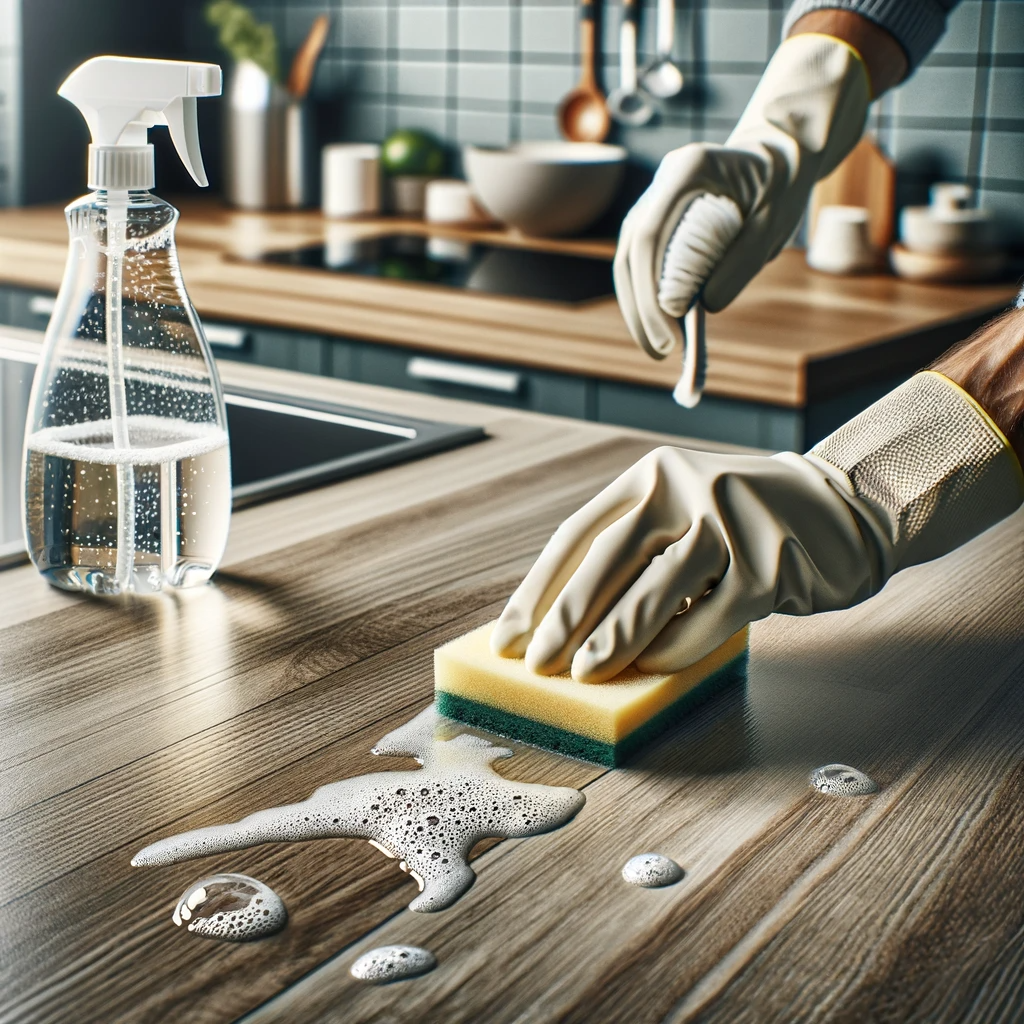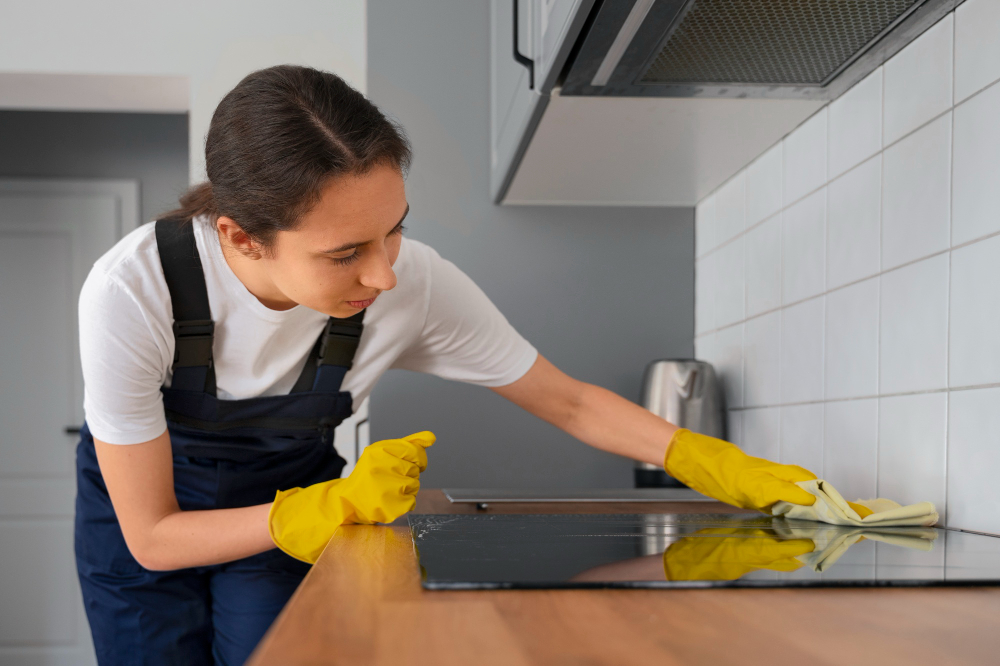How to Clean Laminate Kitchen Worktops

Laminate kitchen worktops are a popular choice in many modern and artsy homes, known for their durability, affordability, and wide array of design options. However, maintaining these surfaces to keep them looking their best requires knowledge of proper cleaning techniques. Unlike other materials, laminate can react differently to various cleaning agents and methods.
Understanding how to clean laminate worktops effectively is essential for preserving their appearance and longevity. Regular cleaning not only keeps these worktops hygienic and aesthetically pleasing but also protects them from wear and tear. This guide will provide insights into the best practices for cleaning laminate kitchen worktops, ensuring they remain a functional and attractive feature in your kitchen.
A guide to cleaning your laminate kitchen worktop
Laminate countertops are versatile and require a straightforward, straightforward method for their care and upkeep. Utilising warm water with mild detergent, use a cloth or sponge regularly to wipe down the surface to avoid build-up of dirt and grime; clean up spills immediately as they occur to avoid potential staining issues. This table provides a comprehensive guide for maintaining the beauty and longevity of laminate kitchen worktops, covering everything from daily cleaning to restoring their shine.
| Cleaning Task | Recommended Products | Instructions |
|---|---|---|
| Daily Cleaning | Mild detergent, soft cloth, microfiber cloth | Use a soft cloth with mild detergent for regular cleaning. Dry with a microfiber cloth to prevent streaks. |
| Stain Removal | Baking soda, water, non-abrasive cloth | Create a paste of baking soda and water for tough stains. Apply gently and wipe clean. |
| Preventing Scratches | Cutting board, soft cleaning pads | Always use cutting boards or pads to prevent scratches from knives or other sharp objects. |
| Dealing with spills | Paper towels, damp cloth | Wipe spills immediately with paper towels, then clean the area with a damp cloth. |
| Restoring Shine | Vinegar solution (1 part vinegar to 2 parts water), soft cloth | To restore shine, clean with a vinegar solution and dry with a soft cloth. |
Clean with warm water.
Laminate countertops may be less susceptible to damage than other countertop materials, but they’re still susceptible to chipping, etching, discoloration, and staining from hot pans and trays.
Avoid these issues by regularly cleaning your worktops with warm water and mild soap. Be sure to rinse and dry properly, as excess moisture can seep into Formica laminate worktop seams and cause them to expand over time.
Avoid using harsh scouring pads, steel wool, or any abrasive brushes on laminate surfaces, as this could permanently scratch or damage them. Instead, opt for soft sponges, paper towels, or microfiber cloths to clean away daily grime or minor stains from daily life.
If your laminate worktops are starting to show signs of age, white vinegar or an equal mix of water and white vinegar may help remove stubborn stains and marks. Be cautious not to use too much of this solution, as too much may damage or degrade the laminate surface.
If you’re uncertain which method will work, consult the instructions of your manufacturer. In most cases, using this approach should remove stubborn marks, returning your laminate surface to looking brand new. If damage exceeds repair, however, replacement might be necessary.
Clean with a mild detergent.
An attractive kitchen worktop will last you for many years to come, provided it’s properly cared for. No matter whether it’s granite, quartz, laminate, or solid wood, every surface requires special care in order to avoid unsightly marks and scratches that mar its beauty, but don’t worry: taking good care doesn’t need to consume all your free time!
If your worktop’s appearance has fallen below par, a quick wipe down with gentle detergent should do just the trick to bring it back to life. When selecting a cleaner specifically tailored for the material of your worktop, ideally neutral pH-balanced cleaners would work best as they won’t damage or discolour it further. However, always test any potential cleaner on a small area first to ensure safety before use.
Cleanliness of countertops is also key for maintaining good hygiene practices, as cluttered surfaces can become homes for bacteria colonies that become difficult to keep under control. Chopping boards should always be used when handling raw meat or fish to prevent cross-contamination with E. coli, Salmonella, Shigella, or Campylobacter bacteria, which could otherwise spread onto worktops.
Applying heat-resistant mats or trivets when placing hot pans onto countertops will protect them from heat marks and scratches, which could otherwise result in heat marks or scars on the countertop. If there is damage done by heat marks or scratches, using mild detergent with warm water could help remove scratches; for more severe marks, try acetone on a cloth to polish away stains using a solvent such as this solution.
Use a microfiber cloth

Compact laminate worktops are easy to keep clean, making them an attractive option for many kitchens. Crafted from tightly pressed layers of card coated in resin, these surfaces are durable and heat-resistant; however, unlike wood or marble countertops, they aren’t as resistant to damage. Therefore, it is crucial that worktops be protected from scratches and heat damage to prevent delamination or warping over time. One way of doing this is by using trivets or heat-resistant mats when placing hot pans and dishes on them while food prep surfaces, which will reduce the chances of scuffing or scratching their surfaces! When preparing food on laminated surfaces, cutting boards reduce the risk of scuffing or scratching the surfaces.
Microfiber cloths can quickly and efficiently remove daily dirt and grease from laminate kitchen worktop surfaces. We advise using mild detergent with warm water; anything too acidic could discolour the material over time; however for tough stains, baking soda-water paste is often effective. Allow this mixture to sit for several minutes before wiping it off the work surface.
Regular waxing of worktop surfaces is also an excellent way to protect them, providing another layer of defence. Be sure to use a non-abrasive, lint-free cloth. Car wax may work on this material too, though more frequent reapplication may be required than with standard kitchen cleaner.
Clean with white vinegar.
White vinegar makes a fantastic everyday kitchen worktop cleaner for many reasons. Not only is it inexpensive and natural, it is gentle on Formica surfaces while simultaneously killing germs that reside there, keeping countertops safe for family usage.
Avoid cleaning products that contain harsh substances like waxes and acids to prevent laminate counters from being damaged. An eco-friendly alternative can be created using white vinegar mixed with some soap in warm water; then dip a microfiber cloth or sponge into this solution before cleaning your surfaces immediately afterward; be sure to rinse and dry immediately afterwards!
If your kitchen countertops have particularly stubborn stains, try mixing a paste of baking soda and vinegar. Apply the mixture directly to the affected spots for several minutes while it works its magic, then wipe away. This technique works great against food-grade grease stains as well as crayon and marker marks.
To keep your laminate worktops free from stains, protect them from heat by using a trivet or placemat when placing hot pans on them. Never place hot trays directly onto laminate counters, as this could burn or delaminate them; additionally, avoid using steel wool scouring pads, which could scratch and discolour them further.
